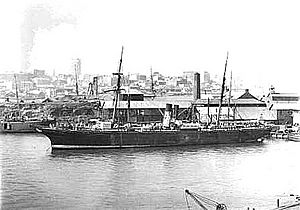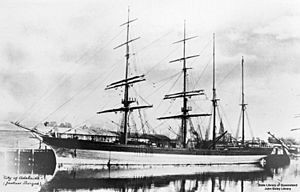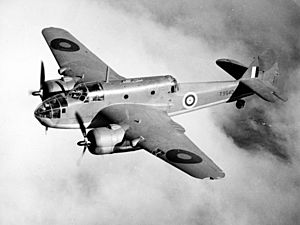SS City of Adelaide (1863) facts for kids

City of Adelaide between 1871 and 1890,
as a two-masted steamship |
|
Quick facts for kids History |
|
|---|---|
| Name | City of Adelaide |
| Owner |
|
| Port of registry | |
| Builder | J & G Thomson, Govan |
| Yard number | 67 |
| Launched | 22 December 1863 |
| Completed | 1864 |
| Out of service | 1912 |
| Identification | |
| Fate |
|
| General characteristics | |
| Type | |
| Tonnage |
|
| Length |
|
| Beam | 28.3 ft (8.6 m) |
| Depth | 16.6 ft (5.1 m) |
| Installed power | until 1890: 200 HP |
| Propulsion |
|
| Sail plan | 1890: jackass barque |
The City of Adelaide was a ship with an iron body. She was built in Scotland in 1863. For many years, she carried people and goods around Australia. Her journey ended when she sank off the coast of Queensland in 1916.
Over her life, the City of Adelaide changed a lot. She started as a ship with three masts and a steam engine. Later, one mast was removed to make more space for passengers. Then, her engine was taken out, and she became a sailing ship with four masts. Finally, she was used as a floating storage for coal.
In 1912, a fire badly damaged the ship. In 1916, her burnt body got stuck in Cockle Bay, near Magnetic Island, Queensland. Years later, in 1942, an Australian Air Force plane crashed into one of her masts, and four people died. In 1971, a big storm called Cyclone Althea broke up part of her wreck. Even today, you can still see her remains in Cockle Bay.
Contents
Building the City of Adelaide
The City of Adelaide was built by a company called J & G Thomson. Their shipyard was in Govan, a town near Glasgow, Scotland. The ship was launched into the water on December 22, 1863, and was finished in 1864.
She was about 246.0 ft (75.0 m) long, 28.3 ft (8.6 m) wide (her beam), and 16.6 ft (5.1 m) deep (her depth). The same company also built her steam engine, which had 200 horsepower to help her move.
The ship was officially registered in Sydney, Australia. Her special identification number was 49261, and her code letters were WCHB.
A Long Career at Sea
The City of Adelaide was a busy ship. She regularly carried passengers between important places like Melbourne, Sydney, Honolulu, and San Francisco.
In 1871, the ship was changed to make more room for people. They took away one of her three masts, so she had only two. She kept working for another 14 years. In 1887, her original owner joined with another company. The City of Adelaide then continued to sail for the new company, the Australasian United Steam Navigation Company.

In 1890, a man named WA Ritchie from Sydney bought the ship. He had her changed again. Her steam engine was removed, and two new masts were added. This made her a four-masted sailing ship called a "jackass barque".
Later, in 1895, GJ Robertson bought her. Then, in 1902, the Howard Smith Company in Townsville bought her. They turned her into a "coal hulk", which means she was used to store coal.
In 1912, a fire broke out on the ship. It burned for several days before it was put out. In 1915, George Butler, whose father was one of the first European settlers on Magnetic Island, bought the burnt ship. He wanted to sink her in Picnic Bay to create a breakwater (a wall to protect a jetty from waves). However, while being pulled to Picnic Bay, the ship got stuck in the shallow water off Magnetic Island's Cockle Bay.
The Wreck of the City of Adelaide
During World War II, the Australian Air Force (RAAF) used the wreck for practice. Their bomber crews from a nearby air base would pretend to attack it. On October 22, 1942, six RAAF Bristol Beaufort planes practiced a bombing run on the wreck.
During this practice, one of the planes seemed to hit a mast of the sunken ship. It then crashed into the shallow sea about 700 metres (770 yd) away. The plane broke apart when it hit the water. Sadly, three RAAF officers and one United States Navy officer on board died instantly.
The wreck is about 300 metres (330 yd) from the shore of Cockle Bay. On December 24, 1971, a powerful storm called Cyclone Althea hit the coast near Magnetic Island. This storm caused part of the wreck's iron body to collapse.
Even so, the wreck still stands like a small, artificial island. It has become a home for many different plants and animals. You can find the wreck at these coordinates: 19°10′29″S 146°49′32″E / 19.174842°S 146.825471°E.
Images for kids
-
City of Adelaide between 1890 and 1902, when she was a four-masted jackass barque






